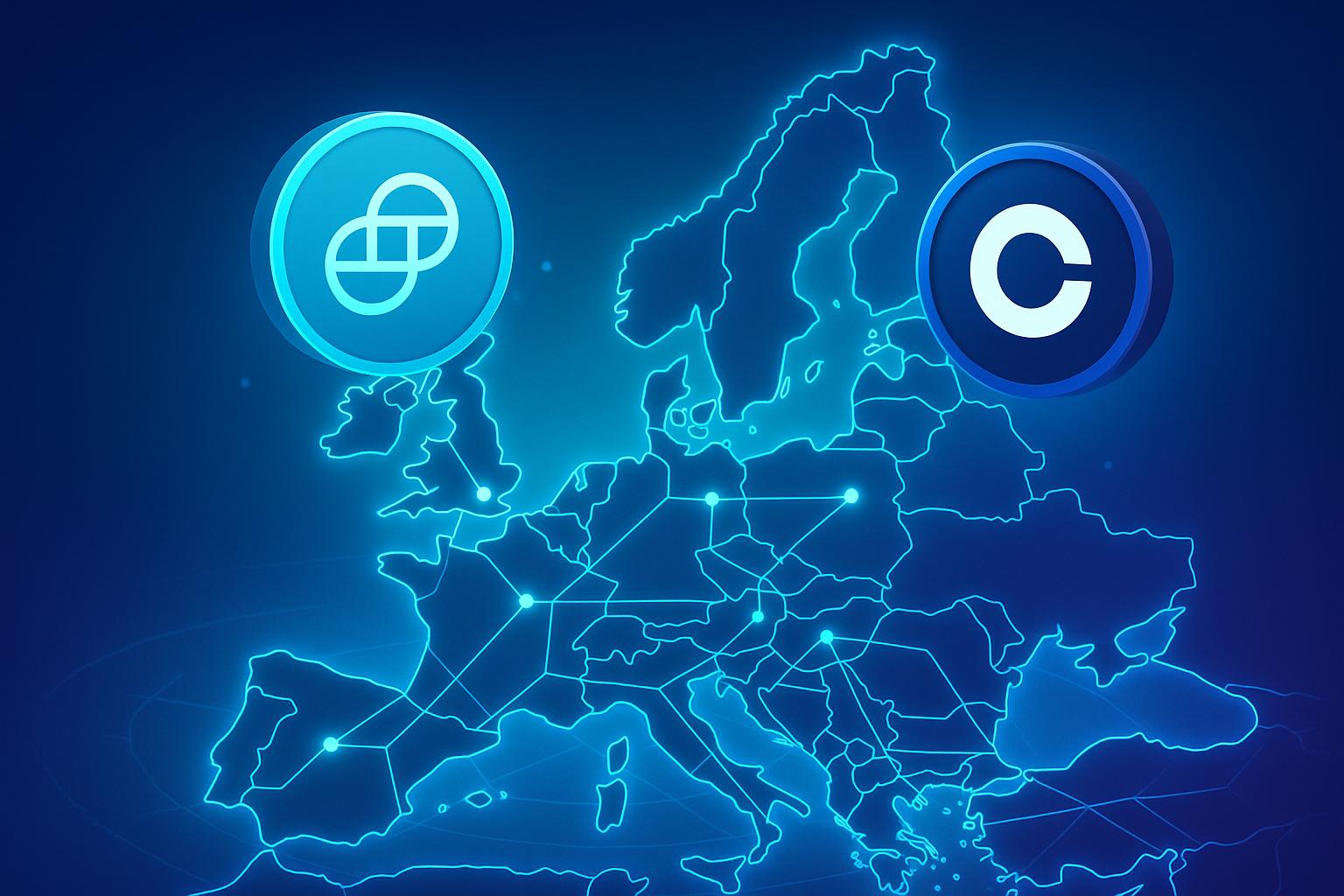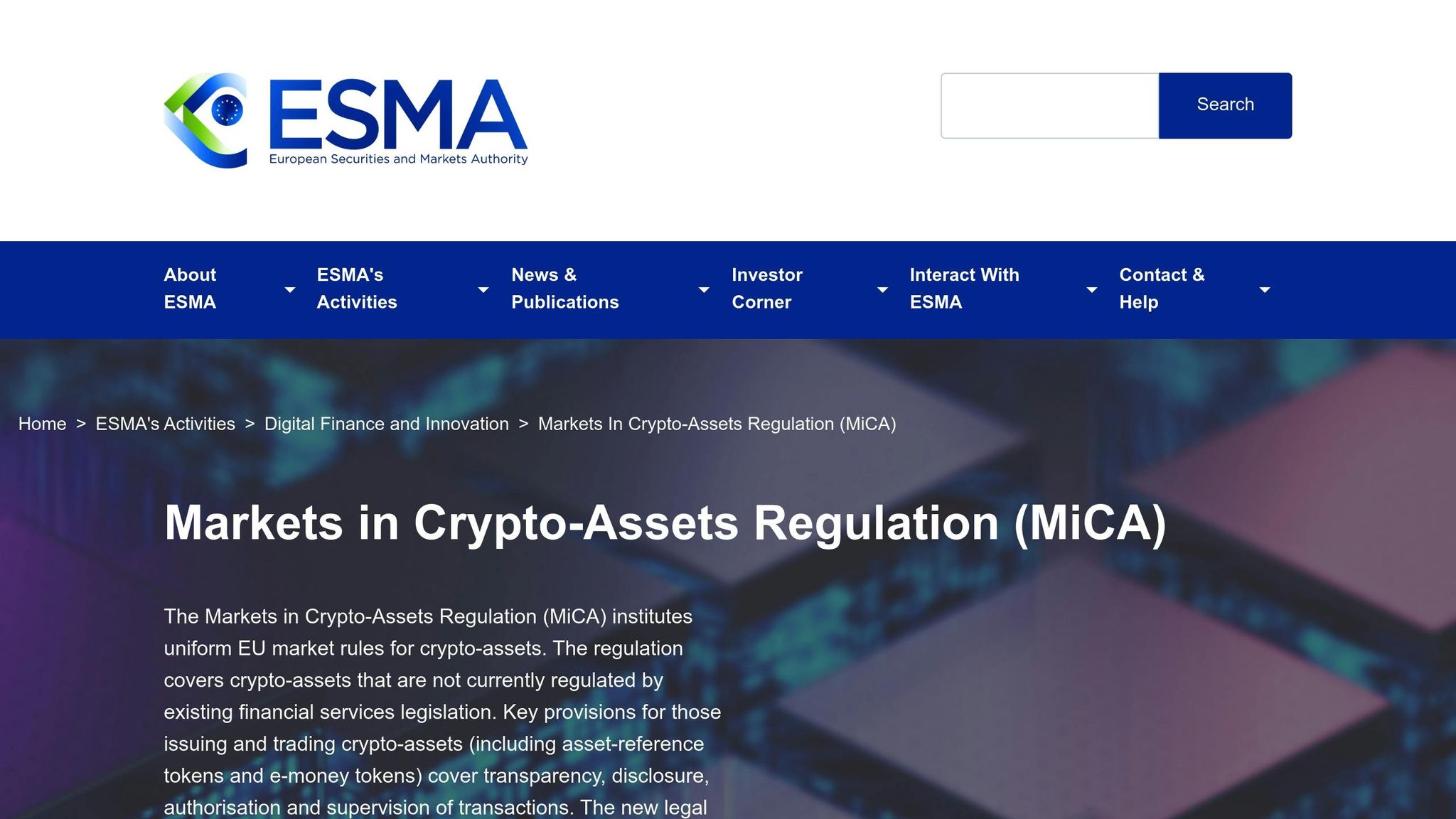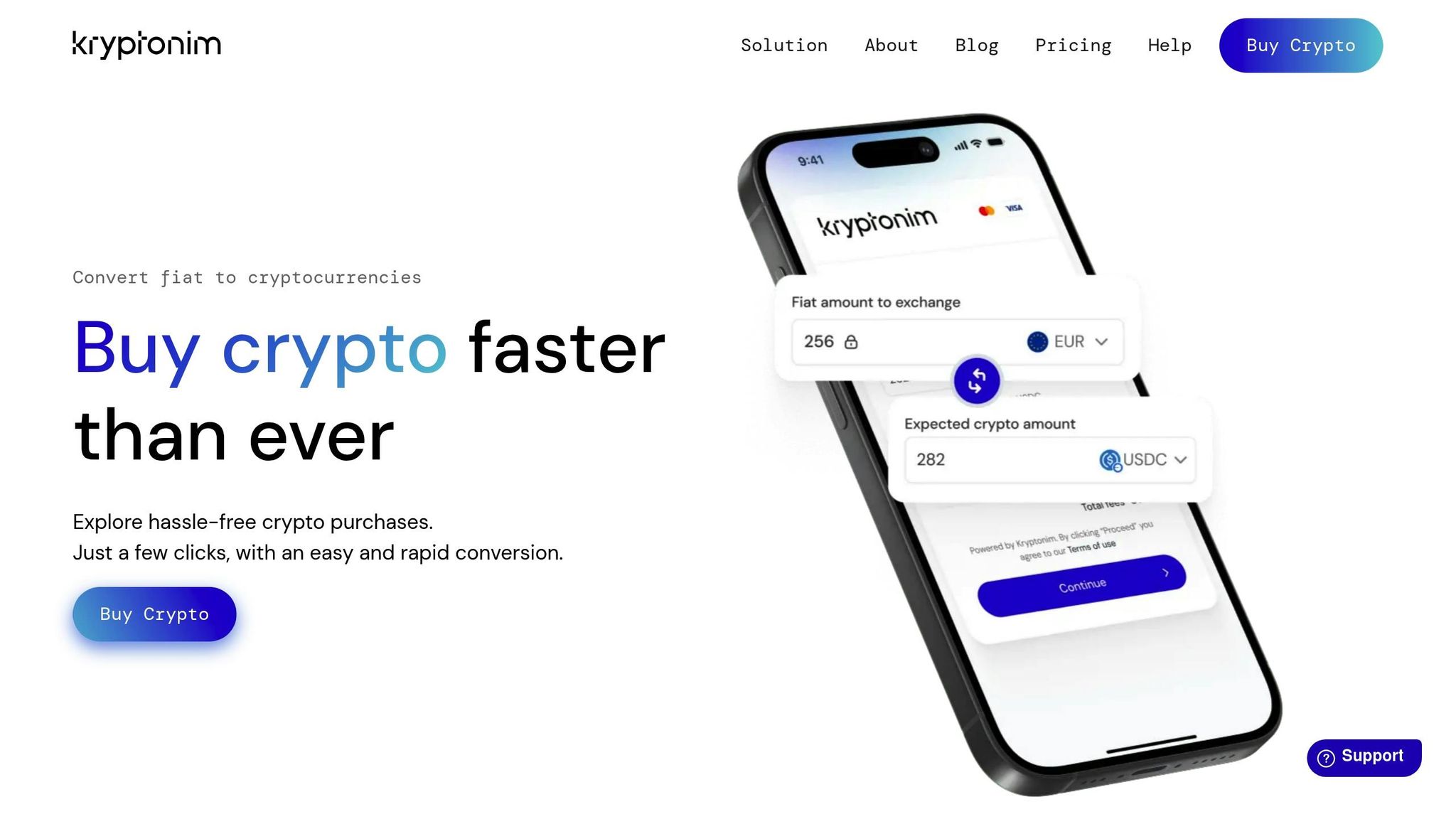Gemini & Coinbase gear up for EU-wide MiCA licenses - What it means
Learn how MiCA regulation is reshaping the EU crypto market, simplifying compliance, and enhancing consumer protection for digital assets.

The European Union’s MiCA regulation is transforming crypto by unifying rules across all 27 member states. Major exchanges like Gemini and Coinbase are pursuing MiCA licenses to simplify operations and expand their reach. Here's what you need to know:
- What is MiCA? MiCA (Markets in Crypto-Assets) sets a single regulatory framework for crypto in the EU, addressing issues like investor protection, anti-money laundering, and market integrity.
- Why it matters: MiCA allows licensed companies to operate across the EU with one license, reducing regulatory complexity. Coinbase, for example, shifted its European hub to Luxembourg after securing a MiCA license.
- Kryptonim’s role: Platforms like Kryptonim, already compliant with MiCA standards, show how smaller firms can compete by adhering to strict rules like KYC, transaction monitoring, and transparent pricing.
- Challenges: Compliance is costly, especially for smaller firms, leading to market consolidation. Non-compliance risks fines ranging from $5.4 million to 12.5% of revenue.
- Benefits for users: MiCA enhances consumer protection with rules against insider trading, stricter asset safeguards, and transparent pricing.
MiCA is reshaping Europe’s crypto market by simplifying regulations, improving trust, and creating opportunities for compliant businesses to grow.
How MiCA Works: Rules and Cross-Border Benefits

MiCA (Markets in Crypto-Assets) is reshaping the crypto landscape in Europe, encouraging many cryptocurrency service providers to obtain EU-wide licenses. To understand its impact, it's essential to look at the licensing and compliance measures that form the backbone of this regulation.
What MiCA Aims to Do
MiCA addresses key issues in Europe's fragmented crypto market, which has grown to a staggering $3.6 trillion in total valuation. Its primary goal? To strike a balance between encouraging innovation and safeguarding consumers from the risks tied to digital assets.
The regulation aims to curb crypto asset misuse, prevent market manipulation, and tackle transparency concerns. By enforcing stricter standards for risk disclosures and fraud prevention, MiCA ensures that consumers are better protected. Beyond consumer safety, it also promotes market integrity and financial stability by regulating the public offering of crypto-assets. This includes setting clear rules around asset issuance, liquidity, and reserve management, creating a unified regulatory framework for all crypto-related activities within the EU.
License and Compliance Rules
MiCA's ambitious goals come with rigorous operational standards. Licensing requirements ensure that only financially stable companies operate in the EU. Crypto-Asset Service Providers (CASPs) must secure a license from their region's regulatory authority. By July 2025, more than 40 CASP licenses had been issued across EU countries, with the majority granted in the Netherlands and Germany.
To comply, CASPs must maintain solid financial reserves, keep client assets - such as stablecoins - separate, and demonstrate strong governance practices.
Operational rules are equally stringent. CASPs must have at least one director based in the EU and maintain a registered office within the region. They are required to implement robust anti-money laundering (AML) measures, protect customer data, and establish effective risk management systems. This includes adhering to Know Your Customer (KYC) protocols, monitoring transactions, and reporting suspicious activities.
Transparency is another cornerstone of MiCA. CASPs must publish clear information about pricing, costs, and fees, as well as the environmental impact of their crypto activities. Regular transparency reports are mandatory to ensure accountability and foster trust among stakeholders. Additionally, marketing materials must be fair and free from misleading claims. These measures collectively ensure that only reliable providers operate in the market, benefiting both businesses and consumers.
Passporting Explained: One License for All EU Countries
One of MiCA's standout features is its passporting mechanism, which removes the hassle of navigating 27 separate regulatory systems. With this system, licensed crypto service providers can operate across all EU countries, mirroring the passport rights seen in other European financial services regulations.
To utilize passporting, a CASP planning to offer services in multiple EU countries must submit detailed information to their home regulatory authority. This includes the types of services they intend to provide, the list of EU countries they plan to operate in, and the expected start date for cross-border services.
For regional crypto businesses, this system offers a streamlined way to expand across the EU market with a single authorization. By focusing on innovation and customer service, companies can thrive under a unified legal framework. For example, firms like Kryptonim, already compliant with EU regulations, gain a clear path to grow while maintaining high standards of compliance that reinforce user trust.
The passporting system simplifies operations, reducing regulatory uncertainty and allowing businesses to operate more efficiently across Europe.
Benefits and Problems with MiCA Rules
MiCA is reshaping the European crypto industry, bringing both opportunities and challenges for businesses navigating this evolving landscape. Its effects depend largely on a company’s size, resources, and existing compliance measures.
Benefits for Regulated Platforms
One of MiCA's standout advantages is the simplification of market access. Instead of dealing with 27 different regulatory systems, crypto firms can now operate across the entire EU with a single license. This eliminates the need for separate authorizations in each member state, streamlining operations significantly.
For businesses already compliant with EU regulations, like Kryptonim, this unified framework offers a leg up. It not only simplifies expansion into European markets but also bolsters trust among users. Additionally, MiCA’s focus on clear risk disclosures and transparent pricing can enhance consumer confidence, making it easier to build stronger relationships with banks, investors, and customers.
However, while the benefits are clear, the regulation also presents a range of compliance challenges.
Compliance Difficulties
MiCA introduces demanding compliance requirements that can be particularly tough for smaller companies. Meeting these regulations often involves hiring specialized staff, adopting advanced technology, and implementing detailed reporting systems. For many, this represents a significant financial and operational burden.
The 24/7 nature of crypto markets adds another layer of complexity. Effective monitoring and reporting go beyond traditional Know Your Customer (KYC) and Anti-Money Laundering (AML) protocols, requiring constant trade surveillance and round-the-clock oversight. This is especially challenging given the diverse range of digital assets.
Non-compliance comes with hefty penalties. Companies risk fines starting at $5.4 million or between 3% and 12.5% of their annual revenue, depending on the severity of the violation. Beyond financial repercussions, non-compliance could result in losing passporting rights and suffering severe reputational damage.
Market Changes: Effects on the Industry
MiCA is also driving significant shifts in the broader market, often favoring larger, more established platforms. By July 2025, only 53 crypto firms had secured EU operating licenses under MiCA. This group included 14 stablecoin issuers and 39 crypto-asset service providers, highlighting the high barriers to entry created by the new regulations.
These challenges have led to market consolidation. Smaller firms, unable to keep up with compliance costs, are either shutting down or merging with larger players. Adoption of MiCA has been slower than expected, with only 25 companies registered as Crypto Asset Service Providers by May 2025. This suggests that many businesses are still struggling to meet the new requirements.
For platforms that can navigate MiCA successfully, the changing market dynamics present opportunities. With reduced competition and increased consumer trust, compliant companies may gain a larger market share and attract institutional investors.
What MiCA Means for Crypto Users
MiCA brings a unified regulatory framework to the EU crypto market, aiming to improve transparency, security, and consumer protections. These changes directly impact users by making the crypto landscape safer and easier to navigate.
Better Consumer Protection and Market Safety
MiCA introduces several measures designed to protect users and ensure market integrity. For starters, crypto-asset issuers are now required to publish detailed whitepapers that clearly outline the nature, features, and risks of their products. This ensures that users have access to essential information before making investment decisions.
The regulation also addresses fund security by requiring robust safeguards, such as keeping client assets separate from company holdings. This is particularly important given past incidents like the 2014 Mt. Gox collapse, where 850,000 Bitcoins were stolen, and the 2017 OneCoin scam, which defrauded investors of over $4 billion globally.
On top of that, MiCA bans insider trading, the unlawful sharing of insider information, and various forms of market manipulation. It also enforces strict rules on advertising and promotions to ensure consumers receive accurate and honest information. To further protect users, service providers must implement effective complaint resolution systems, offering consumers a way to address fraud or mismanagement. And by aligning with the General Data Protection Regulation (GDPR), MiCA requires practices like privacy-by-design and encryption to safeguard personal data.
Using Regulated Platforms Like Kryptonim

MiCA doesn’t just focus on safety - it also improves the user experience on platforms like Kryptonim. For those looking for MiCA-compliant crypto transactions, Kryptonim provides a secure and straightforward option. It adheres to strict accountability standards while offering clear legal recourse in cases of misconduct.
Kryptonim’s pricing structure reflects MiCA’s transparency goals. Users in the EU pay a flat 2% transaction fee with no hidden charges, while users outside the EU are charged 4% per transaction. Additionally, Kryptonim simplifies the process by not requiring an account. It supports local payment methods and offers competitive exchange rates, making it accessible for everyone, from beginners to seasoned traders.
These efforts align with MiCA’s broader vision of modernizing and securing the EU crypto market. By prioritizing user protection and transparency, MiCA is expected to build trust in EU-based crypto services, attracting users who value security and accountability. For those transitioning to MiCA-compliant platforms, the key benefit lies in enhanced safety measures that don’t compromise ease of use. The framework ensures that users across all EU member states enjoy consistent standards for transparency, security, and consumer protection.
sbb-itb-0796ce6
Future of Crypto Rules in Europe
MiCA is set to reshape how cryptocurrencies are regulated across Europe through a structured rollout plan. This phased approach provides a roadmap for regulators and businesses to adapt to the new rules.
MiCA Rollout Schedule
The MiCA framework is being implemented in stages, each with specific deadlines for compliance. After its approval on April 20, 2023, and signing on May 31, 2023, MiCA officially took effect on June 29, 2023. Key dates include June 30, 2024, for rules on ARTs and EMTs, and December 30, 2024, for TFR enforcement.
By January 2025, Crypto Asset Service Providers (CASPs) will need to start applying for licenses to operate within the EU. Transitional measures offer some breathing room for entities already offering services before December 30, 2024, allowing them to continue until July 1, 2026, or until their MiCA authorization is finalized.
The final compliance deadline for all CASPs is July 2026. This timeline gives established platforms like Kryptonim nearly two years to align fully with the new regulations while continuing their operations.
How Regulators Will Oversee the Market
MiCA introduces a layered regulatory system, dividing responsibilities among various bodies. National Competent Authorities (NCAs) in each EU member state will handle local oversight, serving as the primary point of contact for CASPs and issuers.
The European Securities and Markets Authority (ESMA) plays a key role in ensuring consistent regulation across the EU. It develops technical standards, coordinates efforts among member states, and maintains a public registry of authorized CASPs and issuers. ESMA has emphasized a strict approach, stating that no CASP should be deemed low risk.
Evaluate each entity by its size, complexity, cross-border activities, and governance structure.
Meanwhile, the European Banking Authority (EBA) focuses on supervising stablecoin issuers, particularly those issuing ARTs and EMTs, due to their potential systemic impact. The European Commission oversees MiCA's overall effectiveness and can propose updates to align it with other EU financial regulations.
Non-compliance comes with serious penalties. Fines can range from $5.4 million to 3%-12.5% of annual turnover, depending on the severity of the violation. Additional measures include license revocation, suspension of operations, asset freezes, and even personal accountability for executives.
What Comes Next for EU Crypto Markets
MiCA's ambitions go beyond enforcing compliance - it aims to position the EU as a leader in the global crypto market by offering a clear and consistent regulatory framework. With the crypto market already exceeding $3.6 trillion, Europe is poised to claim a significant share of this expanding sector.
The regulation introduces thresholds that will influence market operations. CASPs averaging more than 15 million active EU users annually will be classified as significant CASPs (sCASPs) and face stricter oversight. Likewise, asset-referenced tokens will be deemed widely used if they surpass 1 million transactions and $215 million in daily transaction value within a single currency area.
MiCA’s stringent rules are expected to drive market changes, including consolidation and potential mergers. These shifts may pave the way for future updates addressing areas like DeFi and NFTs. Experts believe MiCA could serve as a blueprint for global crypto regulation, encouraging other regions to adopt similar frameworks and fostering international alignment.
For established platforms like Kryptonim, MiCA offers a clear path for growth. Its focus on transparency, security, and consumer protection aligns with Kryptonim's commitment to providing straightforward, fee-transparent services backed by strong compliance measures.
Conclusion: MiCA's Impact on the Crypto Industry
MiCA simplifies cryptocurrency regulation across Europe by replacing 27 individual national rules with a single, unified framework. This approach not only provides much-needed legal clarity but also ensures strong protections for consumers.
One of MiCA's standout features is its passporting system, which allows platforms with an EU license to operate seamlessly across borders. This creates significant opportunities for compliant companies, such as Kryptonim, to expand their reach within the European Union.
Looking beyond Europe, MiCA's well-defined legal framework could inspire advancements in the global crypto industry. By fostering an environment of transparency and accountability, the regulation encourages the development of new products and services while offering users better protection and dependable services from regulated platforms. As the crypto sector evolves under MiCA's guidance, it sets the stage for a more secure and transparent future.
FAQs
What advantages does MiCA's passporting system offer to crypto companies in the EU?
MiCA’s passporting system makes life easier for crypto companies by allowing them to obtain a single license in one EU country and use it to operate across all member states. This eliminates the hassle of applying for separate licenses in every country, cutting down on red tape and simplifying compliance.
This setup promotes quicker expansion and opens up broader market opportunities. At the same time, it creates a unified set of rules, helping companies grow while following consistent regulations throughout Europe.
What challenges do smaller crypto firms face in meeting MiCA regulations?
Smaller cryptocurrency companies often face challenges in meeting MiCA's demands, primarily due to steep compliance costs. These expenses can include upgrading technology, bringing in specialized personnel, and managing continuous regulatory obligations. For businesses already operating with slim profit margins, such costs can feel like a heavy burden.
On top of that, dealing with intricate licensing processes and deciphering the regulatory landscape can be daunting for smaller teams. This complexity might slow down their ability to enter the market or expand within the EU. Balancing compliance with competitiveness often demands careful planning and considerable resources.
How does MiCA improve consumer protection in the European crypto market?
MiCA enhances consumer protection in the European crypto market by introducing a single regulatory framework. This framework tackles concerns such as market manipulation, fraud, and the improper use of crypto-assets, aiming to improve transparency and accountability across the board.
With uniform rules applied throughout the EU, MiCA works to protect investors and uphold market integrity, creating a safer and more reliable environment for consumers in the crypto space.
